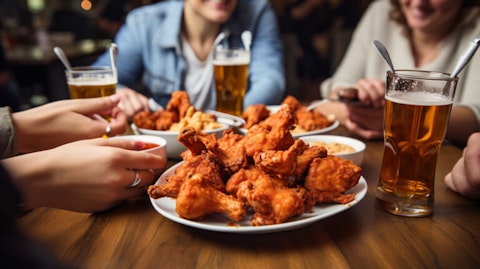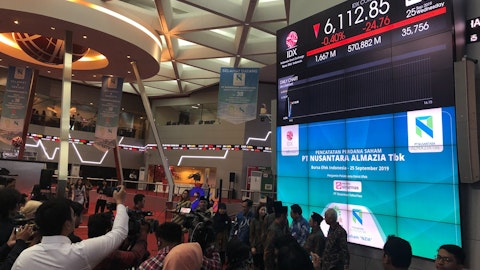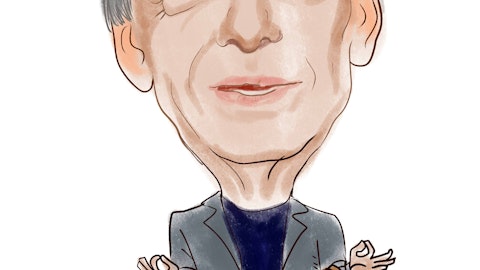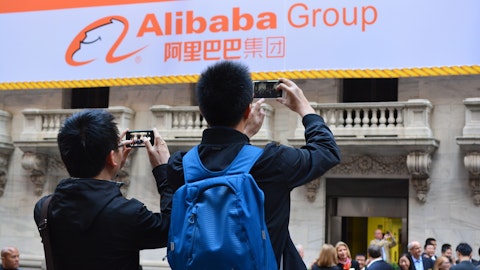Yum China Holdings, Inc. (NYSE:YUMC) Q3 2023 Earnings Call Transcript November 1, 2023
Operator: Thank you for standing by, and welcome to the Yum China, Third Quarter 2023 Earnings Conference Call. I would now like to hand the conference over to Michelle Shen. Please go ahead.
Michelle Shen: Thank you, Zack. Hello, everyone. Thank you for joining Yum China’s third quarter 2023 earnings conference call. On today’s call are our CEO, Ms. Joey Wat; and our CFO, Mr. Andy Yeung. I’d like to remind everyone that our earnings call and investor materials contain forward-looking statements, which are subject to future events and uncertainties. Actual results may differ materially from these forward-looking statements. All forward-looking statements should be considered in conjunction with the cautionary statement in our earnings release and the risk factors included in our filings with the SEC. This call also includes certain non-GAAP financial measures. You should carefully consider the comparable GAAP measures.
Reconciliation of non-GAAP and GAAP measures is included in our earnings release. You can find the webcast of this call and a PowerPoint presentation on our IR website. Now, I would like to turn the call over to Joey Wat, CEO of Yum China. Joey.

Customers savoring boneless wings at a bustling restaurant owned by the company.
Joey Wat: Hello, everyone, and thank you for joining us today. We held our Investor Day in September in Xi’an, China. It was wonderful meeting investors face-to-face. At the event, we unveiled our RGM 2.0 strategy with a strong focus on growth. We have set ambitious growth targets for the coming three years. These include reaching 20,000 stores by 2026, achieving double-digit EPS, CAGR, and returning $3 billion to shareholders in dividends and share repurchases. With our long-term growth commitment in mind, let’s zoom into the third quarter. Our results reflect continued strength. Third quarter net new stores, revenue and adjusted operating profit, all reached record levels. We accelerated new store openings with 500 net new stores in the quarter, while maintaining healthy store payback period.
Our portfolio now exceeds 14,000 stores. System sales grew 15% year-over-year in constant currency. Adjusted operating profit, excluding temporary relief grew 21% year-over-year in constant currency. In the first nine months, adjusted operating profit exceeds $1 billion. Our team’s relentless efforts produced these remarkable results. To drive sales in the peak summer trading season, we bolstered crew resources for excellent service, ensured supply pipeline readiness, and executed traffic-driving campaigns. Same-store sales growth in the third quarter was led by strong transaction growth. During the summer holidays, same-store sales at our tourist and transportation locations surged more than 50% year-over-year. It’s important to remember though, that consumers have continued to be cautious in their spending.
Our formula to capture sales growth has always been simple: Good food, good fun, and exceptional value. Now let me go through what we have done. First, food innovations on a quick scale. Our $100, million-club showcased at Investor Day illustrates our success in building huge categories to boost sales. Recent innovations at KFC include our Juicy Whole Chicken and Beef Burger. To put things into perspective, in the third quarter, these two categories combined exceed 6% of KFC sales mix. This is higher than our Original Recipe Chicken, which we have been proudly serving in China over the past 36 years. It shows our ability to innovate, but also build very big categories. We are continuing to expand these categories with new flavors like Sichuan Style Spicy Whole Chicken, [Foreign Language], offering it from Friday to Sunday only.
This Spicy Whole Chicken is perfect for a home consumption. We also collaborate with Ultraman to promote our premium Ultra Cheese 2.0 Beef Burger. [Foreign Language]. Consumers love them. At Pizza Hut, we sold over 100 million pizzas in the first nine months of the year. One out of every five pizzas we sold was a Durian Pizza. That’s over 20 million Durian Pizza, nearly 70% more year-over-year. Our in-house supply chain worked with suppliers to secure Durian Supplies and expand capacity to satisfy the growing demand. Second, we are offering our customers amazing value for money on top of the innovative food. KFC Crazy Thursdays, [Foreign Language] is no longer just a marketing campaign. It has become a cultural phenomenon. Crazy Thursday sales consistently outperformed other weekdays in the third quarter by around 40%.
To keep customers engaged, we rotate offers and regularly launch new flavor variations such as Spicy Nuggets, [Foreign Language]. We chose products that utilize existing ingredients and involve simple cooking process to provide exceptional value, while ensuring operational efficiency. At Pizza Hut, we are expanding our selections for pizzas priced below RMB50, which is a very significant portion of the overall pizza market. Around 20% of our pizzas we offer are priced below RMB50. And that’s not enough, we could do more. By enriching our lower-priced pizza offerings, we are tapping into this substantial opportunity that’s currently underserved by Pizza Hut. Other than pizzas, we are adding new snacks that customers love. Our new Cheese tart, [Foreign Language], became our best-selling snack in September and an amazing traffic driver.
Not easy for a snack item to be a traffic driver compared to pizza. Next, keeping users engaged and having fun along the way. Our loyalty programs top 460 million members in Q3, up 15% year-over-year. Notably, sales from members continue to be high at 65%. We collaborate with pop culture icons that resonate with young generations. KFC’s campaign was HonKai Star Rail, [Foreign Language]. A popular eGame generated huge social buzz and attracted many new customers. Almost 40% of traffic generated from the campaign came from new or inactive members and a significant portion are young adults, and that’s fantastic news for the brand. We’re proud to be exclusive Western food catering supplier for the Asian Games in Hangzhou. Over 250 of our crew members from across China were chosen to serve at the sporting event.
KFC and Pizza Hut set up nearly 30 pop-up stores and served over 1 million athletes and fans. And it shows that our food is good enough and healthy enough for the professional athletes too. We also ran nationwide campaigns offering exclusive gifts at our restaurants and through our Super App in celebration. In closing, I want to thank all of our teams for their hard work in delivering a strong quarter. Next week, we will hold our RGM Convention for our restaurant General Managers. This marks the first in-person convention for 13,000 attendees since 2019. Very excited about it. It’s an excellent occasion to honor our RGMs dedication, celebrate our achievements, and reaffirm our goals for the coming year and beyond. Looking forward, the growth potential in China remains vast even with moderate economic growth.
RGM 2.0 provides us the strategic framework to grow sustainably. Evolving consumer preferences in the post-pandemic environment require us to stay agile and vigilant. Our robust supply chain and innovative digital ecosystem has enabled us to quickly adapt to changing market conditions. I’m confident we can continue to create long-term value for our shareholders. With that, I will turn the call over to Andy. Andy?
Andy Yeung: Thank you, Joey, and hello everyone. Let me share with you our third quarter performance. But before I do that, I want to point out, foreign exchange had a negative impact of approximately 6% in the quarter. Overall, we achieved solid results growing across key metrics. On a year-over-year basis, revenue grew 15% and adjusted operating profit grew 10% in constant currency. Compared to pre-pandemic levels, we have a much larger store portfolio. Although same-store sales remain at approximately 90% of 2019 levels, system sales grew 22% compared to 2019. With that, let’s go through the financial in more detail. Third quarter total revenues were $2.91 billion in reported currency, a 9% year-over-year increase. In constant currency, total revenue grew 15%.
System sales also increased 15% year-over-year in constant currency. The growth was mainly driven by new unit contributions and same-store sales growth of 4%. Dine-in sales continue to rebound year-over-year. By brand, KFC same-store sales grew 4% year-over-year. A strong rebound at transportation and tourist locations contributed to the growth. Same-store traffic grew 9%, while ticket average decreased 5%. These results were mainly driven by successful traffic driving promotions, lower delivery mix, and rebound of the breakfast daypart. Delivery typically carries a higher ticket average than dine-in orders. Thus, a decline in delivery mix lower the overall ticket average. Breakfast orders tend to have a lower ticket average as well. So the rebound in breakfast sales contributed to traffic growth, but lower ticket average.
Please note that overall ticket average in the third quarter was similar to the second quarter and higher than 2019. Pizza Hut same-store sales grew 2% year-over-year. Same-store traffic grew 12% and ticket average decreased 9%. We want to highlight that by design. We are expanding our price ranges to enhance Pizza Hut’s value propositions and to capture their underserved markets. Consistent with Pizza Hut’s remarginalization plan, we want to enhance Pizza Hut’s value propositions to consumers. Particularly, we are targeting the sub-RMB50 pricing range, which represents a very significant segment of the pizza market in China. We also intend to increase the sale mix of delivery and off-premise dining over time. For Pizza Hut, delivery sales generally have a lower ticket average than dine-in.
Finally, we aim to bolster the sales of single-person meals. This is a different market segment compared to Pizza Hut’s existing customer base, which tends to be group or family dining. Restaurant margin was 17%, 180 basis points lower than the prior year. This was mainly due to lapping of last year’s temporary relief of $30 million, which translates into 120 basis points margin impact. Excluding this impact, year-over-year margin change is only 60 basis points. Wage inflation normalizations of staffing at the store level increased promotional activities, also impacted margins. On a positive side, occupancy and other expenses improved year-over-year, primarily due to sales leveraging and ongoing benefit of cost structure rebasing efforts. Now, let’s go through the key items.
Cost of sales was 31.1%, 40 basis points higher than the prior year. We increased promotional activities to drive traffic sales – I’m sorry, drive sales. And we also faced higher poultry prices in the quarter. This was partially offset by more favorable prices for commodity, including beef and cooking oil, as well as full utilization of chicken. Cost of labor was 25.3%, 180 basis points higher than the prior year. Last year, we benefited from temporary relief of $17 million, which translates into 70 basis points margin impact. Two other key factors that impacted labor cost comparison were, one, mid-single digit wage increase for front-line staff due to annual wage adjustment; and two, normalized staffing level at our stall compared to the pandemic last year.
These were partially offset by sales leveraging. Occupancy and other was 26.6%, 40 basis points lower than the prior year, benefiting from improvement in rent and depreciation expenses. We continue to secure more favorable rental terms for new store. Lower depreciation resulted from lower upfront investment and store portfolio optimization. It’s important to note that 45% of our stalls have been built after 2019. This was partially offset by lapping of $13 million in rental relief and austerity measure associated with the pandemic last year. G&A expenses increased 14% year-over-year in constant currency, mainly from higher accrual of performance-based incentives. And to a lesser extent, near increases and higher travel expenses from the resumption of business travel.
Operating profit was $323 million, increasing 9% in constant currency, excluding $30 million in temporary relief received last year, adjusted operating profit to 21% in constant currency. Our effective tax rate was 27.5%. We continue to expect our full year effective tax rate to be around 30%. Net income was $244 million, and diluted EPS was $0.58, both increasing 18% in reported currency. Excluding the foreign exchange impact, net income increased 26% and diluted EPS 27% in constant currency. We generated $410 million in options cash flow and $243 million in free cash flow in the third quarter. We returned $211 million to shareholders in cash dividends and share repurchase in the quarter, on track to return $600 million to $800 million for the full year 2023.
Our balance sheets remain strong with around $4.2 billion in net cash positions by the end of the third quarter. Now, let’s turn to our outlook. Regarding store opening, we opened 500 net new stores in the quarter and 1,155 net new stores year-to-date. We are on track to meet our 2023 full year target of 1,400 to 1,600 net new stores. The new store payback period for our KFC and Pizza Hut store remains healthy at two years and three years respectively. With our healthy new unit payback, together with flexible formats and modules, we are confident to reach 20,000 stores by 2026, as we unveiled at our Investor Day. Looking ahead, the fourth quarter is seasonally a small quarter for both sales and profit. On the sales side, since the late September, we have observed softening demand, which extended to October.
Consumers have become more value conscious. We have been focusing on food innovation and widening pricing ranges to tap into underserved market to drive growth. Regarding margins, sales remain the biggest factor. Fluctuation in sales may have a pronounced impact on margins in the fourth quarter. As a reminder, in the fourth quarter last year, we also received 26 million in temporary relief, which we do not expect to repeat this year. We also anticipate wage inflation of mid-single digits and returning to more normalized staffing levels at our store. Just as a reminder, in the fourth quarter last year, we experienced labor shortage due to widespread COVID infections. The post pandemic economic recovery is shaping up to be a wave-like and nonlinear process.
So we will maintain our focus on tracking sales and cost efficiency. However, the overall trend towards recovery is evident this year, and many of our performance metrics are setting new records. We have demonstrated our ability to quickly adapt to changing consumer preferences and seize opportunities under different market conditions. We are confident that the successful execution of our RGM 2.0 strategy will help us expand our store portfolio, grow sales, and boost profit, delivering sustainable value creation and long-term returns to shareholders. With that, I will pass you back to Michelle. Michelle.
Michelle Shen: Thanks, Andy. Now we’ll open the call for questions. In order to give more people the chance to ask questions, please limit your questions to one at a time. Zach, please start the Q&A.
See also 13 Most Undervalued Pharma Stocks To Buy According To Analysts and 11 Undervalued Mid Cap Stocks To Buy According to Analysts.
Q&A Session
Follow Yum China Holdings Inc. (NYSE:YUMC)
Follow Yum China Holdings Inc. (NYSE:YUMC)
Receive real-time insider trading and news alerts
Operator: Thank you. [Operator Instructions]. Your first question comes from Michelle Cheng from Goldman Sachs. Please go ahead.
Michelle Cheng : Hi, Joey and Andy. Thanks for taking my question. My question is still about the competition. Especially you mentioned that the trend turned softer since the end of September. So, can you share with us how do you see the competition landscape evolve? And also with this value campaign, how should we think about the balance between the top line growth and also the food cost control? Thank you.
Joey Wat : Thank you, Michelle. Regarding the competition, we see it as a positive trend in time, because despite some concern towards the macro situation in China, in the media, in reality, both international and domestic players are investing aggressively in our industry. That shows that these players, competitors, are voting with their money and voting with their feet. And that’s consistent to our view towards the business and our industry in China, particularly for the chain store business model. On top of that, we see very vibrant competition in the lower tier city. Again, that is good because if you remember back to our Investor Day, we have very aggressive store opening plan, especially in the lower tier city. And that resonate well with our view that there’s a lot of opportunity in the lower tier cities.
So, we’re quite happy to see that. And then when it comes to the point about value driven consumer, we have been a player that has benefited from the more cautious and more rational spending for the consumers. We’re a fast food company. When customer becomes more value driven, it’s good for us, as far as we have the capability to deliver and we do. And it has been a consistent focus for our company, to focus not only value, but innovative products and fun experience, because value itself is never enough for our customers and we’ll continue to do that. And you can see that in this quarter, in the past many years, we have been very consistent with our ticket average. With the ups and down, our ticket average compared to the last sort of more stable year, 2019, is still up a little bit, because we are very careful about it.
We can see price increase every year in Pizza Hut during the turnaround time for the original product, we kind of keep the price the same, but then we get a bit more opportunity with the new product. But the ticket average has been relatively stable. And even in the last quarter, you can see we have very healthy growth of transaction, TC. And our business, TC growth is sober. I mean, it cannot be better to have TC growth. So it shows that we react very quickly and we are very agile and we get the sales. Last but not the least, while we are doing all this innovative product, we deliver value products for [inaudible]. We are able to prepare our margin with our innovations and value campaign and that is very important. In fact, our year-to-date margin has already exceeded that of 2019, which is pre-pandemic.
There’s some movement, I mean Andy – I’m sure Andy will go through it later on. There’s some movement between the different lines of cost structure, but the restaurant margin, that’s what we could tell. We reduced the rent, we reduced the O&O, and then we put the money into food and to service, to serve our customers. So net-net, competitiveness is good, because we see it’s a vote of confidence for our industry and our market. Thank you, Michelle.
Michelle Shen : Thank you, Joey. That’s very clear.
Operator: Your next question comes from Lin Sijiefrom CICC. Please go ahead.
Lin Sijie: Thank you, Joey and Andy. So I have one question regarding the margin. So Andy has mentioned the reasons behind the margins year-over-year change, but if we compare Q3 with the same quarter in 2019, our revenue increased 26%, but operating profit only increased 8%, which is quite different with Q1 and Q2. So could you please help us better understand this? Thank you.
Andy Yeung : Okay. Thank you for the questions. And so as you mentioned, if you look at the year-over-year comparisons, you definitely need to take out the impact from the temporary relief last year. And when we compare to 2019, obviously over the past few years, we continue to see the labor costs that was increasing over the past few years. But we’re able to possibly offset that by improvement in our O&O, which is occupancy and other expenses. And then if you look at by item, you see that COS is actually pretty stable, about 31%. Our COS as mentioned, because of wage inflations and a high mix of delivery, we have seen some increase there. However, O-to-O side, we are much better, mainly benefiting from store portfolio optimizations and rent negotiations and better lease terms.
And we also have other initiatives to rebase our cost structure to possibly offset that. If you look at the same-store sales, which is about 90% level of the 2019. Now, looking at that, as we mentioned a little bit earlier, looking ahead in the fourth quarter, fourth quarter is a smaller quarter for us in terms of sales and profit. And so as we have mentioned, we have seen some softening demand since September, so sales fluctuation will have a more pronounced impact on the profitability and margin. Now, again, in the fourth quarter compared to last year, last year we received $26 million of temporary relief, which we do not expect to repeat this year. Now, in terms of wage inflation, let me just repeat it again, mid-single-digit wage inflation, normalization of staffing levels at our store.
Longer term, as we have mentioned at our investor day, we – our goal is to maintain a stable margin and potentially improve it over time. Obviously we have to work hard to continue to offset wage inflation impact every year and potentially commodity inflation in the long term. It’s important to keep, a short-term and long-term balance in mind. We will continue to benefit from cost-structural rebasing efforts that will stay in place for a long time. For example, high level rent; our megastore restaurant staff sharing program. We also have more flexible and lower investment for our store model. So we’ll maintain our discipline in cost, efficiencies, and also continue to improve productivity. That’s how we look at the margins in both short-term and long-term.
Thank you.
Michelle Shen : Thank you, Andy.
Operator: Your next question comes from Christine Peng with UBS. Please go ahead.
Christine Peng: Thank you, management. I actually have a question which is also related to competition, but I want to ask more details specifically in terms of this Chinese-style burger. I think in the Investor Day, Yixiang [ph], your KFC management actually shared with investors, KFC’s plan to launch the Chinese-style burger products in the very near future. So can management share with us the timetable, as well as more specifics about this product in terms of price strategy, product strategy going forward? Thank you.
Joey Wat : Thank you, Christine. We actually have test launched this particular product in three provinces already, Tianjin and Fujian in particular. So it’s interesting that we test launched it – not in Guangzhou, Beijing or Shanghai. We do it instead of second tier cities. And the progress has been good, and we are happy with the result and we continue to work on a plan and then move to next stage when we are ready. The price point is competitive. It’s very affordable. And it’s one of our strategies that for the lower tier city, we have slightly different product and a more affordable pricing. But at the same time, we still maintain the margin for the business. But it’s going well. I tasted the product myself. It tastes great. So hopefully next time we can get it closer to Hong Kong where you can – you don’t have to travel that far to try it. Thank you, Christine.
Operator: Your next question comes from Chen Luo from Bank of America. Please go ahead.
Chen Luo: Hi, Joey and Andy. So my question is also on competition. In fact, last time in Xi’an, I also raised a question on testing and the likes of TikTok coupons. And I think given our current value campaign and our initiatives to broaden our price range, as well as to sell more coupons on TikTok, do we think that the ticket average decline that we saw in Q3 could actually extend into the coming few quarters? And would the ticket count increase, can be enough to offset the ticket average decrease? Lastly, in terms of our food and paper cost as percentage of sales, do you think that in the near term, it could be under some pressure on a year-on-year basis into the coming few quarters? Thank you.




